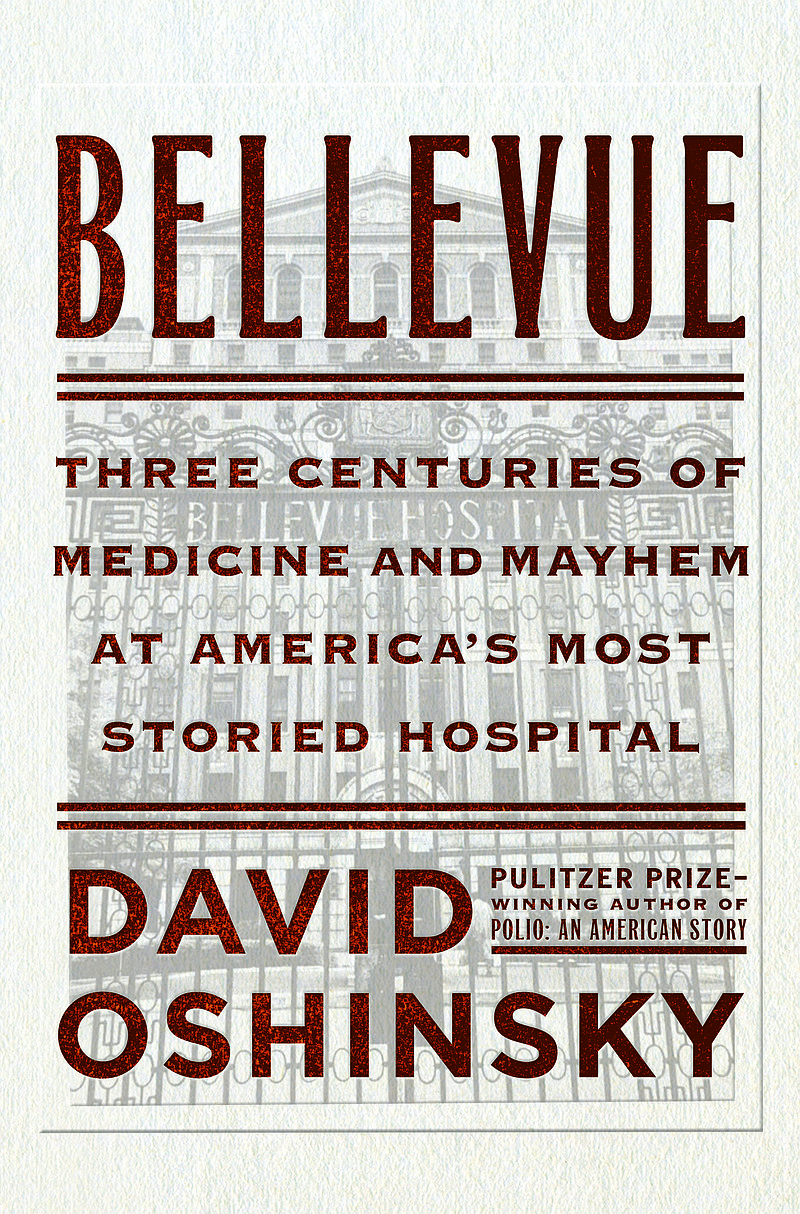A fault line lies across the history of Bellevue Hospital so that the rumble of major social trends, political history and, less surprisingly, changes in scientific understanding create seismic waves that ripple through the iconic Manhattan hospital. In fact, when it comes to medical history, some of the waves begin at Bellevue.
David Oshinsky follows these many tremors in this deeply engrossing history, "Bellevue: Three Centuries of Medicine and Mayhem at America's Most Storied Hospital."
"They come knowing they won't be turned away," Oshinsky writes. "Every immigrant group has availed itself of Bellevue's protective umbrella over the centuries; every disaster and epidemic has packed its Spartan wards."
In its 300-year history, thousands of the humble and the famous (William S. Burroughs, Eugene O'Neill, Charlie Parker, Leadbelly, Saul Bellow, Allen Ginsberg, Norman Mailer, to name a few) have crowded its corridors. Hosts of medical students and doctors followed for the unrivaled experience of treating every kind of disease, accident and misfortune suffered by Bellevue's patients.
Epidemic disease overflowed Bellevue's wards in repeated waves-from yellow fever in the 1790s through AIDS in the 1980s and '90s.
The Civil War filled Bellevue's beds, depleted its medical staff and, ultimately, led to innovations we take for granted-ambulance service and professional nursing. Its doctors battled their own civil war as medicine moved from the idea that disease was spread by bad air-miasmas-to a knowledge of germs, and the grim truth that physicians were contributing to the death of their patients. Prohibition left its mark in the rising number of horrific poisonings-government mandated the inclusion of poison in industrial alcohol-and in the declining number of people seeking admission for alcohol problems.
In more recent decades, crack cocaine and the surge of homelessness nearly overwhelmed it. These were perhaps the hospital's biggest threat until Superstorm Sandy overwhelmed it, leading Bellevue to close its doors for the only time in its long history.
There is no easy narrative path through this material, yet Oshinsky has wrestled an institutional history of significant complexity into a compelling tale. Winner of the 2006 Pulitzer for "Polio: An American Story," Oshinsky is a master of finding and relating memorable anecdotes to embody the history. The result is a serious story studded with juicy and occasionally blood-curdling bits from the past: physicians experimenting on the unknowing patients, rats frolicking in the wards, gruesome murder trials in which Bellevue's forensic experts play roles in nail-biting whodunits. Oshinsky also tackles the more daunting aspects of the Bellevue story, such as the role and funding of public hospitals, a potentially dry topic brought vividly to life through Bellevue's repeated fights to thrive and, at times, to survive.
Bellevue's role in medical history is not easily matched. Bellevue surgeons Andre Frederic Cournand and Dickinson Richards developed cardiac catheterization and shared the 1956 Nobel Prize in medicine for their work. Bellevue surgeon Frank Hasting Hamilton created the battlefield surgical manual in the Civil War. Another Bellevue surgeon, Stephen Smith, launched the practice of public health and defeated Tammany Hall and its powerful Boss William Magear Tweed when he attacked the squalor of city tenements and their role in the spread of typhus.
But prominence extracts a price. And it was a Bellevue surgeon who played a pivotal if unfortunate role in the acceptance of antiseptic surgical procedures by American doctors. When President James Garfield was shot by an assassin in July 1881, Frank Hamilton, whose efforts were so important to Civil War medicine, was summoned to the president's bedside. Unfortunately, Hamilton was an old-school holdout in an argument raging at Bellevue. While some of his surgical colleagues disinfected their hands, instruments, patients and patient dressings, Hamilton was unconvinced, and actually ridiculed a meticulous fellow surgeon as "demented."
"Had the responding physicians done nothing more than make Garfield comfortable, he almost certainly would have survived," Oshinsky writes. Instead, Hamilton and David Hayes Agnew of the University of Pennsylvania Medical School examined Garfield "without pausing to wash their hands or clean their instruments." Two and a half months later, the president died, wracked by multiple infections. His autopsy results set off a long-overdue national debate over antiseptic surgery.
But despite its role in the history of medicine and the country, Bellevue, above all things, has been a place for people with nowhere else to turn. "The patients it currently serves are every bit as poor and needy as the patients who preceded them in centuries past. And those with viable options almost always wind up going somewhere else," Oshinsky writes. "That's what makes Bellevue so comforting and so disquieting. It stands, for all its troubles, as a vital safety net, a place of caring and a place of last resort."

